Research Highlights 2021
Understanding Thermal and A-Thermal Trapping Processes in Lead Halide Perovskites Towards Effective Radiation Detection Schemes

Lead halide perovskites (LHP) are rapidly emerging as efficient, low-cost, solution-processable scintillators for radiation detection. Carrier trapping is arguably the most critical limitation to the scintillation performance. Nonetheless, no clear picture of the trapping and detrapping mechanisms to/from shallow and deep trap states involved in the scintillation process has been reported to date, as well as of the role of the material dimensionality. Here, this issue is addressed by performing, for the first time, a comprehensive study using radioluminescence and photoluminescence measurements side-by-side to thermally-stimulated luminescence (TSL) and afterglow experiments on CsPbBr3 with increasing dimensionality, namely nanocubes, nanowires, nanosheets, and bulk crystals. All systems are found to be affected by shallow defects resulting in delayed intragap emission following detrapping via athermal tunneling. TSL further reveals the existence of additional temperature-activated detrapping pathways from deeper trap states, whose effect grows with the material dimensionality, becoming the dominant process in bulk crystals. These results highlight that, compared to massive solids where the suppression of both deep and shallow defects is critical, low dimensional nanostructures are more promising active materials for LHP scintillators, provided that their integration in functional devices meets efficient surface engineering.
Rodà C.; Fasoli M.; Zaffalon M.L.; Cova F.; Pinchetti V.; Shamsi J.; Abdelhady A.L.; Imran M.; Meinardi F.; Manna L.; Vedda A.; and Brovelli, S. Understanding Thermal and A-Thermal Trapping Processes in Lead Halide Perovskites Towards Effective Radiation Detection Schemes. ADVANCED FUNCTIONAL MATERIALS, 31, 2104879 (2021).
Anionic Polymerization in Porous Organic Frameworks: A Strategy to Fabricate Anchored Polymers and Copolymers
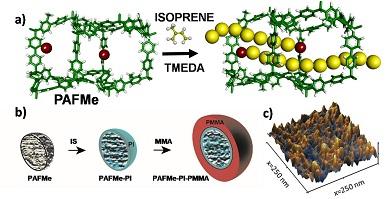
An anionic mechanism is used to create polymers and copolymers as confined to, or anchored to, high-surface area porous nanoparticles. For the first time, linear polymers with soft and glassy chains, such as polyisoprene (PI) and polymethylmethacrylate (PMMA), were produced by confined anionic polymerization in 3D networks of porous aromatic frameworks (PAFs). Alternatively, multiple anions were generated on the frameworks and initiate chain propagation, resulting in chains covalently connected to the 3D network. Sequential reactions were promoted by the living character of this anionic propagation, yielding nanoparticles that were covered by a second polymer anchored by anionic block copolymerization. The intimacy of the matrix and the grown-in polymers was demonstrated by 2D 1H-13C-HETCOR NMR spectra.
Perego, J.; Bracco, S.; Comotti, A.; Piga, D.; Bassanetti, I.; Sozzani, P. Anionic Polymerization in Porous Organic Frameworks: A Strategy to Fabricate Anchored Polymers and Copolymers. ANGEWANDTE CHEMIE INTERNATIONAL EDITION 60, 6117 (2021).
Gandini, M.; Villa, I.; Beretta, M.; Gotti, C.; Imran, M.; Carulli, F.; Fantuzzi, E.; Sassi, M.; Zaffalon, M.; Brofferio, C.; Manna, L.; Beverina, L.; Vedda, A.; Fasoli, M.; Gironi, L.; Brovelli, S. Efficient, fast and reabsorption-free perovskite nanocrystal-based sensitized plastic scintillators. NATURE NANOTECHNOLOGY 15, 462–468 (2020).
Cascade Dynamics of Multiple Molecular Rotors in a MOF: Benchmark Mobility at a Few Kelvins and Dynamics Control by CO2
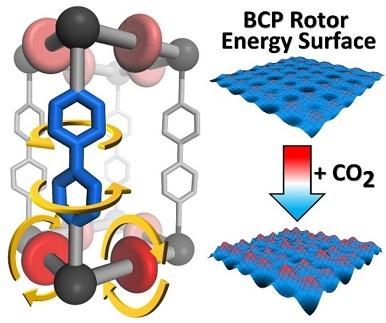
Achieving sophisticated juxtaposition of geared molecular rotors with negligible energy-requirements in solids enables fast yet controllable and correlated rotary motion to construct switches and motors. Our endeavor was to realize multiple rotors operating in a MOF architecture capable of supporting ultrafast motional regimes, even at extremely cold temperatures (107 Hz at 4 K). Two distinct ligands coordinated to Zn clusters fabricated a pillar-and-layer 3D array of orthogonal rotors. Variable temperature XRD, 2H solid echo, and 1H T1 relaxation NMR, collected down to a temperature of 2 K revealed the hyperfast mobility of BCP and an unprecedented cascade mechanism modulated by distinct energy barriers starting from values as low as 24 cal mol−1, a real benchmark for complex arrays of rotors. These rotors explored multiple configurations of conrotary and disrotary relationships, switched on and off by thermal energy, a scenario supported by DFT modeling. CO2 diffused through the open pores, dramatically changed the global rotation mechanism.
Perego, J.; Bezuidenhout, C. X.; Bracco, S.; Prando, G.; Marchiò, L.; Negroni, M.; Carretta, P.; Sozzani, P.; Comotti, A. Cascade Dynamics of Multiple Molecular Rotors in a MOF: Benchmark Mobility at a Few Kelvins and Dynamics Control by CO2. JOURNAL OF THE AMERICAN CHEMICAL SOCIETY, 143, 13082 (2021).
Sb-Doped Metal Halide Nanocrystals: A 0D versus 3D Comparison
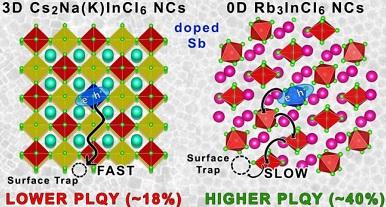
We synthesize colloidal nanocrystals (NCs) of Rb3InCl6, composed of isolated metal halide octahedra (“0D”), and of Cs2NaInCl6 and Cs2KInCl6 double perovskites, where all octahedra share corners and are interconnected (“3D”), with the aim to elucidate and compare their optical features once doped with Sb3+ ions. Our optical and computational analyses evidence that the photoluminescence quantum yield (PLQY) of all these systems is consistently lower than that of the corresponding bulk materials due to the presence of deep surface traps from under-coordinated halide ions. Also, Sb-doped “0D” Rb3InCl6 NCs exhibit a higher PLQY than Sb-doped “3D” Cs2NaInCl6 and Cs2KInCl6 NCs, most likely because excitons responsible for the PL emission migrate to the surface faster in 3D NCs than in 0D NCs. We also observe that all these systems feature a large Stokes shift (varying from system to system), a feature that should be of interest for applications in photon management and scintillation technologies. Scintillation properties are evaluated via radioluminescence experiments, and re-absorption-free waveguiding performance in large-area plastic scintillators is assessed using Monte Carlo ray-tracing simulations.
Zhu, D.; Zaffalon, M. L.; Zito, J.; Cova, F.; Meinardi, F.; De Trizio, L.; Infante, I.; Brovelli, S.; Manna, L. Sb-Doped Metal Halide Nanocrystals: A 0D versus 3D Comparison. ACS Energy Letters, 6, 6, 2283–2292 (2021).
Operando visualization of the hydrogen evolution reaction with atomic-scale precision at different metal–graphene interfaces
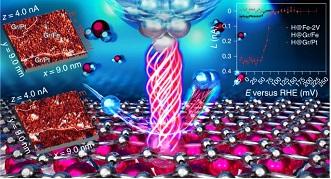
The development of catalysts for the hydrogen evolution reaction is pivotal for the hydrogen economy. Thin iron films covered with monolayer graphene exhibit outstanding catalytic activity, surpassing even that of platinum, as demonstrated by a method based on evaluating the noise in the tunnelling current of electrochemical scanning tunnelling microscopy. Using this approach, we mapped with atomic-scale precision the electrochemical activity of the graphene–iron interface, and determined that single iron atoms trapped within carbon vacancies and curved graphene areas on step edges are exceptionally active. Density functional theory calculations confirmed the sequence of activity obtained experimentally. This work exemplifies the potential of electrochemical scanning tunnelling microscopy as the only technique able to determine both the atomic structure and relative catalytic performance of atomically well-defined sites in electrochemical operando conditions and provides a detailed rationale for the design of novel catalysts based on cheap and abundant metals such as iron.
Composite fast scintillators based on high-Z fluorescent metal–organic framework nanocrystals
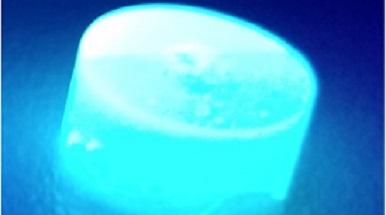
In this study, the researchers designed a composite material, made of a processable polymeric matrix that incorporates scintillating Metal- Organic Frameworks (MOFs) nanocrystals, thus demonstrating an improvement in the scintillation efficacy. This multicomponent material would allow the fabrication of radiation detector more sensitive and with a better time response to be employed in TOF-PET to enhance the imaging accuracy and scanner sensitivity.
Treatment with ROS detoxifying gold quantum clusters alleviates the functional decline in a mouse model of Friedreich ataxia

The Friedreich Ataxia (FRDA) is a neurodegenerative disease caused by an abnormality in the gene that codes for a protein called frataxin. This disease mainly affects the central and peripheral nervous system and generally arises in the age of puberty, manifesting itself with ataxia of the limbs. In this work, we demonstrate how reactive oxygen species (ROS) scavenging quantum cluster of gold atoms improve the mitochondrial activity and function, thus reducing the oxidative damage in the patients affected by the FRDA.
Role of Dihydride and Dihydrogen Complexes in Hydrogen Evolution Reaction on Single-Atom Catalysts
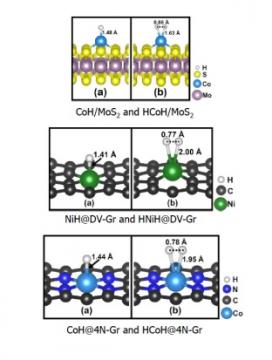
The hydrogen evolution reaction (HER) has a key role in electrochemical water splitting. A lot of attention has been dedicated to HER from Single Atom Catalysts (SAC) and the activity of SACs in HER is rationalized or predicted using models derived for metal surfaces where the only intermediate that forms are H atoms adsorbed on the metal electrode. However, SACs differ substantially from metal surfaces, and can be considered analogs of coordination compounds. In coordination chemistry, at variance with metal surfaces, stable dihydride or dihydrogen complexes (HMH) can form. We have shown that stable HMH intermediates, in addition to MH ones, can form on SACs and that this changes the kinetics of the process. The work provides an example of the important analogies between the chemistry of SACs and that of coordination compounds.